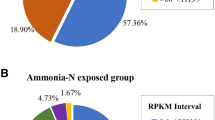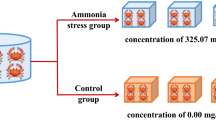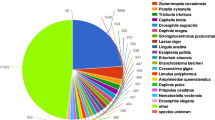Abstract
Chinese mitten crab, Eriocheir sinensis, is an economically important crab in China. Air exposure is a common stress for E. sinensis, especially during the harvest and transportation. Several studies have investigated the effects of air exposure stress on E. sinensis at physiological and molecular levels. However, the common and distinct mechanisms adopted by male and female crabs to cope with air exposure stress remain unclear. In this study, we performed a comparative transcriptome analysis from hepatopancreatic tissue of female and male Chinese mitten crabs in response to air exposure stress. In total, 428 and 1 322 differentially expressed genes (DEGs) were identified in female and male crabs under air exposure, respectively. Our results showed that the transcriptional levels of several glycolysis related genes and anti-apoptotic proteins were up-regulated in both female and male crabs in response to air exposure. Moreover, our findings indicated that female E. sinensis might preferentially increase the expression of heat shock proteins (HSPs) to deal with air exposure stress, while male E. sinensis tend to resist air exposure stress via increasing antioxidant enzyme expression. Overall, this study provides novel insights into the molecular mechanisms underlying the air exposure stress response of E. sinensis.
Similar content being viewed by others
Data Availability Statement
The datasets generated and/or analyzed during the current study are available from the corresponding author on reasonable request.
References
Abeyrathne E D N S, Huang X, Ahn D U. 2018. Antioxidant, angiotensin-converting enzyme inhibitory activity and other functional properties of egg white proteins and their derived peptides—a review. Poultry Science, 97(4): 1462–1468.
Bao J, Li X D, Xing Y N, Feng C C, Jiang H B. 2019a. Respiratory metabolism and antioxidant response in Chinese mitten crab Eriocheir sinensis during air exposure and subsequent reimmersion. Frontiers in Physiology, 10: 907.
Bao J, Xing Y N, Jiang H B, Li X D. 2019b. Identification of immune-related genes in gills of Chinese mitten crabs (Eriocheir sinensis) during adaptation to air exposure stress. Fish & Shellfish Immunology, 84: 885–893.
Bolhassani A, Agi E. 2019. Heat shock proteins in infection. Clinica Chimica Acta, 498: 90–100.
Chen X W, Wang J, Hou X, Yue W C, Li Z H, Wang C H. 2019. Gene expression profiles of gill provide insights into the aerial respiration capacity of the Chinese mitten crab, Eriocheir sinensis. Aquaculture, 506: 148–153.
Cheng C H, Ma H L, Deng Y Q, Feng J, Chen X L, Guo Z X. 2020a. Transcriptome analysis and histopathology of the mud crab (Scylla paramamosain) after air exposure. Comparative Biochemistry and Physiology Part C: Toxicology & Pharmacology, 228: 108652.
Cheng J H, Lv X Y, Pan Y Y, Sun D W. 2020b. Foodborne bacterial stress responses to exogenous reactive oxygen species (ROS) induced by cold plasma treatments. Trends in Food Science & Technology, 103: 239–247.
Cui Z X, Liu Y, Yuan J B, Zhang X J, Ventura T, Ma K Y, Sun S, Song C W, Zhan D L, Yang Y, Liu H R, Fan G Y, Cai Q L, Du J, Qin J, Shi C C, Hao S J, Fitzgibbon Q P, Smith G G, Xiang J H, Chan T Y, Hui M, Bao C C, Li F H, Chu K H. 2021. The Chinese mitten crab genome provides insights into adaptive plasticity and developmental regulation. Nature Communications, 12: 2395.
Davis S M, Pennypacker K R. 2017. Targeting antioxidant enzyme expression as a therapeutic strategy for ischemic stroke. Neurochemistry International, 107: 23–32.
Duan Y F, Zhang Y, Dong H B, Zhang J S. 2016. Effect of desiccation on oxidative stress and antioxidant response of the black tiger shrimp Penaeus monodon. Fish & Shellfish Immunology, 58: 10–17.
Frazee A C, Pertea G, Jaffe A E, Langmead B, Salzberg S L, Leek J T. 2015. Ballgown bridges the gap between transcriptome assembly and expression analysis. Nature Biotechnology, 33: 243–246.
Frenkel L, Dimant B, Portiansky E L, Maldonado H, Delorenzi A. 2008. Both heat shock and water deprivation trigger Hsp70 expression in the olfactory lobe of the crab Chasmagnathus granulatus. Neuroscience Letters, 443(3): 251–256.
Huang A M, Geng Y, Wang K Y, Zeng F, Liu Q, Wang Y, Sun Y, Liu X X, Zhou Y. 2013. Molecular cloning and expression analysis of heat shock protein 90 (Hsp90) of the mud crab, Scylla paramamosain. Journal of Agricultural Science, 5(7): 1–11.
Ivanina A V, Sokolov E P, Sokolova I M. 2010. Effects of cadmium on anaerobic energy metabolism and mRNA expression during air exposure and recovery of an intertidal mollusk Crassostrea virginica. Aquatic Toxicology, 99(3): 330–342.
Jacob R A. 1995. The integrated antioxidant system. Nutrition Research, 15(5): 755–766.
John T. 2009. Hsps and aging. Trends in Endocrinology & Metabolism Tem, 20(5): 216–222.
Kim D, Langmead B, Salzberg S L. 2015. HISAT: a fast spliced aligner with low memory requirements. Nature Methods, 12: 357–360.
Kondrikov D, Fulton D, Dong Z, Su Y C. 2015. Heat shock protein 70 prevents hyperoxia-induced disruption of lung endothelial barrier via caspase-dependent and AIF-dependent pathways. PloS One, 10: e0129343.
Li C Z, Weng S P, Chen Y G, Yu X Q, Lü L, Zhang H Q, He J G, Xu X P. 2012. Analysis of Litopenaeus vannamei transcriptome using the next-generation DNA sequencing technique. PLoS One, 7: e47442.
Li M X, Wang X D, Qi C L, Li E C, Du Z Y, Qin J G, Chen L Q. 2018. Metabolic response of Nile tilapia (Oreochromis niloticus) to acute and chronic hypoxia stress. Aquaculture, 495: 187–195.
Li X H, Cui Z X, Liu Y, Song C W, Shi G H. 2013. Transcriptome analysis and discovery of genes involved in immune pathways from hepatopancreas of microbial challenged mitten crab Eriocheir sinensis. PLoS One, 8: e68233.
Limón-Pacheco J, Gonsebatt M E. 2009. The role of antioxidants and antioxidant-related enzymes in protective responses to environmentally induced oxidative stress. Mutation Research, 674(1–2): 137–147.
Liu M M, Jiang X D, Chen A Q, Chen T, Cheng Y X, Wu X G. 2020. Transcriptome analysis reveals the potential mechanism of dietary carotenoids improving antioxidative capability and immunity of juvenile Chinese mitten crabs Eriocheir sinensis. Fish & Shellfish Immunology, 104: 359–373.
Livak K J, Schmittgen T D. 2001. Analysis of relative gene expression data using real-time quantitative PCR and the 2−2ΔΔCt method. Methods, 25(4): 402–408.
Lou Y P, Li C, Landis A G, Wang G L, Stoeckel J, Peatman E. 2014. Transcriptomic profiling of differential responses to drought in two freshwater mussel species, the giant floater Pyganodon grandis and the Pondhorn Uniomerus tetralasmus. PLoS One, 9: e89481.
MOA (Ministry of Agriculture). 2020. China Fishery Statistical Yearbook: 2020. China Agriculture Press, Beijing, China. (in Chinese with English abstract)
Mutz K O, Heilkenbrinker A, Lönne M, Walter J G, Stahl F. 2013. Transcriptome analysis using next-generation sequencing. Current Opinion in Biotechnology, 24(1): 22–30.
Picard D. 2002. Heat-shock protein 90, a chaperone for folding and regulation. Cellular and Molecular Life Sciences, 59(10): 1640–1648.
Pratt W B, Toft D O. 2003. Regulation of signaling protein function and trafficking by the hsp90/hsp70-based chaperone machinery. Experimental Biology and Medicine, 228(2): 111–133.
Ridgway I D, Taylor A C, Atkinson R J A, Stentiford G D, Chang E S, Chang S A, Neil D M. 2006. Morbidity and mortality in Norway lobsters, Nephrops norvegicus: physiological, immunological and pathological effects of aerial exposure. Journal of Experimental Marine Biology and Ecology, 328(2): 251–264.
Shan R T, Liu N, Yan Y Y, Liu B. 2021. Apoptosis, autophagy and atherosclerosis: relationships and the role of Hsp27. Pharmacological Research, 166: 105169.
Steenvoorden D P T, van Henegouwen G M J B. 1997. The use of endogenous antioxidants to improve photoprotection. Journal of Photochemistry and Photobiology B: Biology, 41(1–2): 1–10.
Sun S M, Guo Z B, Fu H T, Zhu J, Ge X P. 2018. Integrated metabolomic and transcriptomic analysis of brain energy metabolism in the male Oriental river prawn (Macrobrachium nipponense) in response to hypoxia and reoxygenation. Environmental Pollution, 243: 1154–1165.
Sun Y, Lu Y F, Saredy J, Wang X W, Iv C D, Shao Y, Saaoud F, Xu K M, Liu M, Yang W Y, Jiang X H, Wang H, Yang X F. 2020. ROS systems are a new integrated network for sensing homeostasis and alarming stresses in organelle metabolic processes. Redox Biology, 37: 101696.
Trivedi S, Lal N. 2017. Antioxidant enzymes in periodontitis. Journal of Oral Biology & Craniofacial Research, 7(1): 54–57.
Vitorino H A, Alta R Y P, Ortega P. 2019. Lipid peroxidation in hepatopancreas, gill, and hemolymph of male and female crabs Platyxanthus orbignyi after air exposure. Journal of Marine Science and Engineering, 7(10): 347.
Wang M, Wang L, Zhou Z, Gao Y, Wang L, Shi X, Gai Y, Mu C, Song L. 2013. The molecular characterization of a catalase from Chinese mitten crab Eriocheir sinensis. International Journal of Immunogenetics, 40(3): 230–240.
Xie Q Q, Liu Y, Li X F. 2020. The interaction mechanism between autophagy and apoptosis in colon cancer. Translational Oncology, 13(12): 100871.
Yu A Q, Jin X K, Guo X N, Li S, Wu M H, Li W W, Wang Q. 2013. Two novel Toll genes (EsToll1 and EsToll2) from Eriocheir sinensis are differentially induced by lipopolysaccharide, peptidoglycan and zymosan. Fish & Shellfish Immunology, 35(4): 1282–1292.
Zhang X Y, Zhang M Z, Zheng C J, Liu J, Hu H J. 2009. Identification of two hsp90 genes from the marine crab, Portunus trituberculatus and their specific expression profiles under different environmental conditions. Comparative Biochemistry and Physiology Part C: Toxicology & Pharmacology, 150(4): 465–473.
Acknowledgment
The authors are grateful to all the laboratory members.
Author information
Authors and Affiliations
Corresponding author
Additional information
Supported by the National Key R&D Program of China (No. 2018YFD0900303), the National Natural Science Foundation of China (No. 32072964), and the Ten Thousand Talents Program, and Scientific Research Foundation of Graduate School of Ningbo University
Rights and permissions
About this article
Cite this article
Zhang, Y., Ni, M., Zheng, J. et al. Transcriptome of Eriocheir sinensis under air exposure. J. Ocean. Limnol. 40, 766–774 (2022). https://doi.org/10.1007/s00343-021-0449-7
Received:
Accepted:
Published:
Issue Date:
DOI: https://doi.org/10.1007/s00343-021-0449-7




